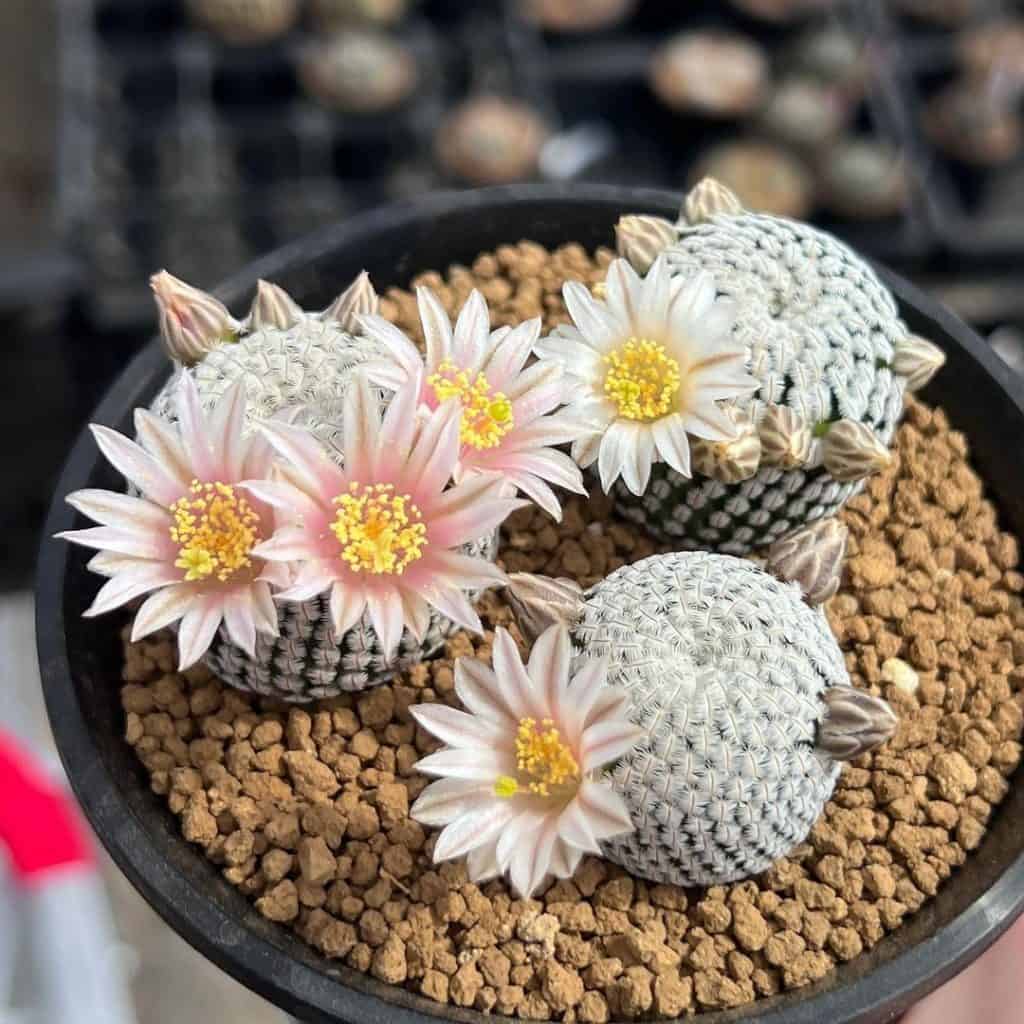Mammillaria pectinifera: The Tiny Cactus with a Feathery Appearance
You know what’s totally captivating? A cactus that looks like it’s covered in fuzzy feathers instead of sharp spines! Meet Mammillaria pectinifera – possibly the fluffiest little cactus you’ll ever lay eyes on. This pint-sized plant native to Mexico is a quirky gem that’ll instantly brighten up your day (and your indoor garden!).
With its unique appearance and easy-breezy care requirements, Mammillaria pectinifera is an absolute must-have for cactus aficionados and plant novices alike. So get ready to be charmed by nature’s feathery marvel as we dive into everything you need to know about growing this miniature showstopper!

Contents
About Mammillaria pectinifera
This diminutive cactus is a true surprise package! Mammillaria pectinifera typically grows as a solitary stem, though propagation can sometimes result in multiple cute offshoots. Its stems can be round and globular or slightly flattened in shape, but they max out at only around 6 inches tall.
The real showstoppers are those white, flattened spines adorning the plant. Instead of sharp spines like most cacti, Mammillaria is covered in downy, feather-like tufts. This gives it an unexpectedly soft, fuzzy appearance – a delightful contrast to its pokey cousins!
Though sometimes mistakenly called “peyote,” there is little evidence that this cactus was used ceremonially or has psychoactive properties. It’s simply an ornamental wonder.
When mature, Mammillaria pectinifera can be a bit temperamental to cultivate on its own roots. However, grafting it makes for easier growth. This slow-growing plant also rarely produces offsets, so propagation is best done from seed.
With its petite stature, unique feathery outfit, and quirky growing habits, Mammillaria pectinifera definitely stands out from the crowd. It’s an appealing and unusual choice for cactus fans and succulent lovers alike. Keep reading to learn all the tips for keeping this charming plant healthy and happy!
Related Post:
39 Mammillaria Cactus Types and Care [With Pictures]

How to Care for Mammillaria pectinifera
Light Requirements
Mammillaria pectinifera can adapt to a range of light exposures, from light shade to full sun. However, introducing it gradually to sunnier conditions is best to prevent sunburn. When grown indoors, provide bright, direct light from an east or west-facing window or supplement with a grow light.
Water Needs
Be very careful with watering this rot-prone cactus. During the active growing season in spring and summer, water regularly but only when the soil is completely dry. A deep, infrequent watering is preferable to frequent, light waterings. In winter when dormant, reduce watering to once a month at most to avoid rot.
Soil Preferences
This cactus has a fairly large taproot, so it requires a very well-draining, mineral-based potting mix in a deep container. A blend of potting soil, coarse sand or perlite, and a small amount of bark or pumice will provide the perfect, fast-draining environment.

Fertilizing Guidelines
Feed every 2 weeks during the growing season with a diluted, high-potassium cactus fertilizer. This provides the nutrients needed for healthy budding and growth. No fertilizer is required during the winter dormancy period.
Temperature and Humidity
Mammillaria pectinifera thrives in average household temperatures between 65-85°F (18-29°C). Avoid extreme cold or heat, and maintain low humidity levels around 40% to prevent rot or fungal issues.
Pests and Problems
Keep an eye out for common cactus pests like mealybugs or scale insects. If spotted, treat with an insecticidal soap or neem oil solution. Fungal infections can occur from overwatering or poor air circulation – remove affected areas promptly.
Pruning
Pruning is generally unnecessary for this slow-growing cactus. However, if any damaged or discolored segments appear, carefully remove them with clean, sharp scissors or pruners.
Potting and Repotting
Use a well-draining container with ample drainage holes, and repot every 2-3 years when the plant becomes rootbound. Gently remove the cactus from its current pot, disturbing the roots as little as possible, and replant in fresh soil.

Mammillaria pectinifera Propagation Methods
Mammillaria pectinifera rarely produces offsets, so propagation is best done from seed. Sow seeds directly after the last frost, following the instructions in the main propagation section. Be patient, as this is a slow-growing species even from seed.
